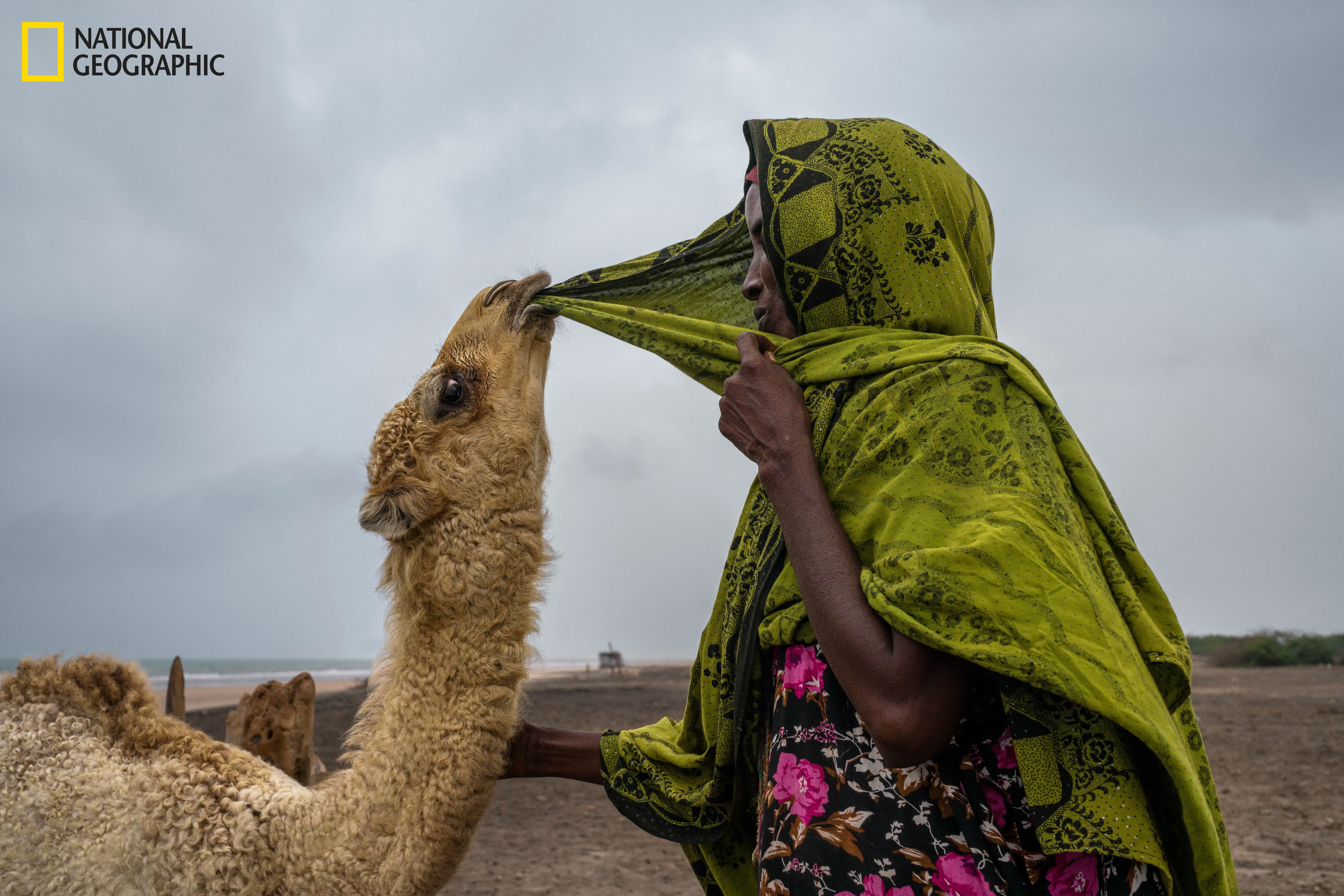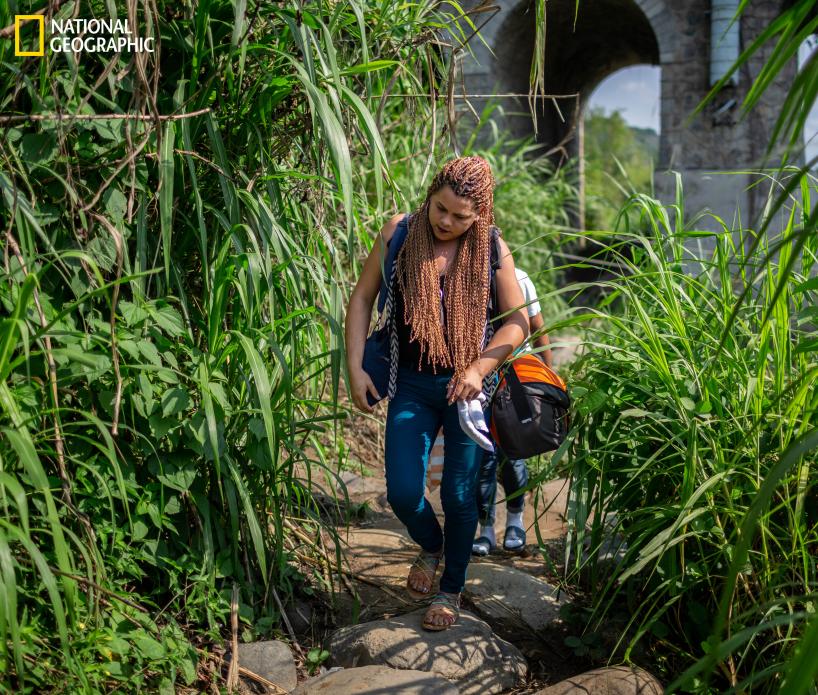Warm-up: Exploring the themes of "Women On The Move" and the ways that infographics can communicate information.
Introducing the Resource: Introduction to the infographic from "Women On The Move," which visualizes migration patterns worldwide.
Engaging with the Resource:
- Understanding the Infographic (multiple choice and fill-in-the-blank questions)
- Exploring the Infographic using a graphic organizer
- Comprehension Questions
Discussion Questions: Evaluating migration trends presented in the project
Extension Activities:
- Create an infographic that explores the migration trends of a specific location
- Analyze another underreported story on migration

"Women On The Move" explores the hope and resilience of women who have left their homes in search of new lives. This lesson examines an infographic within the project, called "Crossing Borders," that provides a closer look at migration patterns. Students will learn how to read and actively engage with the infographic to identify who is migrating, where they are migrating, and where there are gender gaps in migration patterns. Critically engaging with this data will help students contextualize the themes of "Women on the Move," which also uses photography and text to share stories from eight women about their experiences migrating.
For additional lessons and resources connected to "Women on the Move" from National Geographic, click here.
Objectives:
Students will be able to…
- Analyze text from the article "Women On The Move" to understand why people are migrating.
- Practice examining data from an infographic, with the help of a graphic organizer.
- Evaluate data to analyze migration trends: who is migrating, the number of people migrating, where they are migrating, and why there are gender gaps.
- Choose a new place and create their own visual representation of migration trends for that location.
Warm-up:
- Think: What does hope and resilience look like? Think of a time when you experienced hope and/or resilience in your life. When was it? What happened? Did you run into any obstacles?
- Share with a partner: What was an example of hope and resilience in your life? What challenge(s) were you facing, and how did you find hope and resilience?
- Discuss with the class: What do you know about migrants? Why do you think a person might want to leave their city or country for another? How might people who are migrating experience hope and resilience? What challenges might they face?
- "Women On The Move" is a project that follows the stories of eight women from different parts of the world as they migrate from their city or country of origin to a new destination. This project uses photography to give readers a glimpse into their lives. Consider the following:
- How do visuals help you engage with stories?
- How can photography help us better understand the experiences of people as they migrate?
- An infographic is another type of visual that helps communicate new information. Infographics help break down important data so we can gain a better understanding of an issue. This lesson will explore an infographic that depicts migration trends across the world.
- Predict: What do you think an infographic can tell us about why people are migrating, where migration is happening, and how migration patterns may look alike or different for women?
Introducing the Resource:
The infographic from "Women on the Move," which is called "Crossing Borders," illustrates the migration patterns of millions of people in 2019. Click here to visit find the infographic on the project page. As you explore using the applications below, use the infographic to analyze the following:
- Why are people traveling?
- Where are people traveling from, and where are they going?
- How do travel patterns look differently for women and men?
Engaging with the Resource:
For the following activities, examine migration data presented in the infographic.
- Understanding the Infographic: What do the colors and shapes indicate?
- Circle the answer for each question below:
- What does a circle with a green border indicate?
- A person's destination
- A person's origin
- What does a circle with a purple border indicate?
- A person's destination
- A person's origin
- What does a circle with a green border indicate?
- Fill in the blanks for the following five questions:
- If a country has a light orange color fill, this means that more _________ than _________ moved here.
- If a country has a dark orange color fill, this means that more _________than_________moved away.
- If a country has light grey shading, this means that the number of women and men who moved here or moved away is the _________.
- If a country has a light blue color fill, this means that fewer _________ than _________ moved here.
- If a country has a teal color fill, this means that fewer _________ than _________ moved away.
- Circle the answer for each question below:
- Exploring the Infographic: Use this graphic organizer to record your answers for the following:
- List the countries where more women than men moved away.
- List the countries where fewer women than men moved away.
- For each country, list the gender gap between men and women. This information—which explains how many more or fewer women are leaving the country than men—can be found in the graph at the bottom left of the infographic.
- Comprehension Questions:
- Use the introduction to the infographic to answer the following questions:
- What are some of the reasons that migration has increased over the past two decades? Why are people choosing to migrate?
- In countries that are key destinations for migrant women, the participation of migrant women in the labor force exceeds that of nonmigrant women by what percentage?
- What are some of the risks and challenges that women face when they are migrating alone?
- Use the infographic visuals to answer the questions below:
- How old are most women who leave home for another country?
- What number of international migrants are migrant workers?
- According to the infographic, what is the number of migrant women in the United States?
- How many women left the United States?
- Which two countries did the 1.2 million female migrants in Argentina travel from?
- How many migrants do the European Union (EU) nations host? Why did most of these migrants come to the EU?
- Which country has the largest number of its citizens living abroad? How many? Are there more women or men?
- What is the destination for most African migrants?
- Use the introduction to the infographic to answer the following questions:
Discussion Questions:
Now that you have had time to engage with the data, take time to evaluate the migration trends presented in "Women On The Move." Use details from the infographic to reflect on the following questions as a class, in small groups, or on your own.
- Trends indicate that women are traveling for education or work. Why do you think there has been an increase in women traveling independently of other family members in the past two decades?
- The reporting tells us that "often the decision to leave is not a choice." What does this mean? At what point do you think a person might feel like they don't have a choice?
- What surprised you about migration trends as you looked at the infographic?
- In countries where many people are choosing to leave and migrate somewhere new, what do you think could be the impacts on people who remain in those countries?
- How could the COVID-19 pandemic complicate the journeys for migrants? Refer to the project for examples.
Extension Activities:
- Create an infographic that explores the migration trends of a specific location.
- Choose a place and conduct your own research to examine migration trends in that place. You may choose to focus on a region, country, state, or smaller community. Not sure where to start? Try the migration portal from the United Nations and the Institute of Migration. Use the following questions to guide your research:
- Are many people migrating to this place? Why are they migrating?
- Are many people leaving this place? Why are they leaving?
- What do lives look like for migrants who are leaving this place, or arriving in this place?
- Who is migrating? What are the gender dynamics for migrants—from origin to destination? What do the lives of children who are migrating look like?
- Choose how you want to visually present your research. You may choose to use the infographic from "Women On The Move" as inspiration, or, you may decide to present your research differently. As you prepare, think:
- What do you want your audience to see?
- How can you clearly present your information?
- Choose a place and conduct your own research to examine migration trends in that place. You may choose to focus on a region, country, state, or smaller community. Not sure where to start? Try the migration portal from the United Nations and the Institute of Migration. Use the following questions to guide your research:
- Analyze another underreported story on migration.
- Visit www.pulitzercenter.org/reporting to locate a news story on migration. Use keywords and advanced search tools to find stories that include other issues or specific countries that interest you.
- Use the following questions to critically engage with your chosen story:
- What details stood out to you from the story the journalist reported? Use these details to write a three-five sentence summary of the story.
- Why is this story important?
- What connections can you make between this story, and issues/people/places in your own community?
CCSS.ELA-LITERACY.RST.9-10.1: Cite specific textual evidence to support analysis of science and technical texts, attending to the precise details of explanations or descriptions.
CCSS.ELA-LITERACY.RST.9-10.2: Determine the central ideas or conclusions of a text; trace the text's explanation or depiction of a complex process, phenomenon, or concept; provide an accurate summary of the text.
CCSS.ELA-LITERACY.RST.6-8.4: Determine the meaning of symbols, key terms, and other domain-specific words and phrases as they are used in a specific scientific or technical context.
CCSS.ELA-LITERACY.RST.6-8.5: Analyze the structure an author uses to organize a text, including how the major sections contribute to the whole and to an understanding of the topic.





